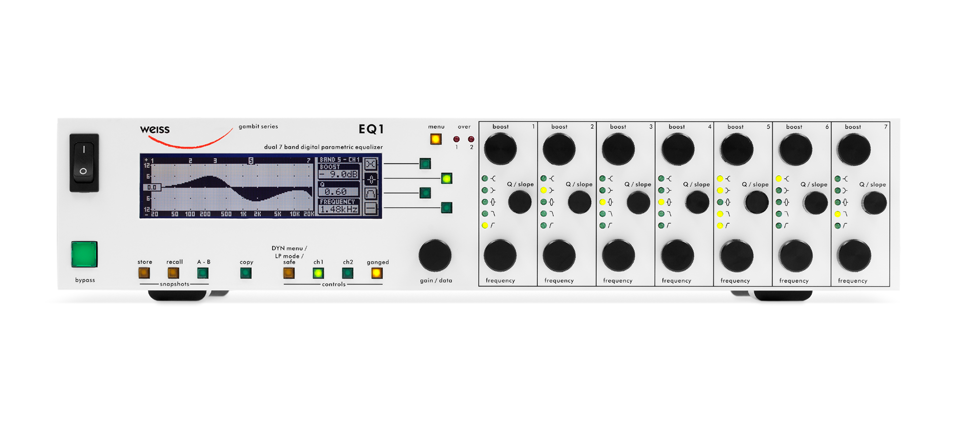Weiss EQ1-MK2
7.080,00 €*
Weiss EQ1 mk2The Weiss EQ1 is available in four different configurations. All of them work at 24/96. The basic model is the EQ1MKII, the linear phase model is the EQ1-LP, the dynamic model the EQ1-DYN. The EQ1-DYN-LP incorporates both LP and DYN versions in one unit. The mode of operation (LP or DYN) can be chosen after power-up. All models are user-upgradeable to any other version. Here are the main features common to all four models:
Seven identical parametric bands. All seven bands cover the entire audio frequency range. Each band has Boost/Cut, Frequency and Q/Slope knobs. Each band operates in any of the following modes: High shelving, low shelving, peaking, high cut, low cut, bypass.
One parameter per knob operation. Seven sets of controls for seven operating bands. Knobs are touch sensitive. LCD display shows detailed parameters of the touched band.
Large, backlit Liquid Crystal Display which shows the overall frequency response (calculated in real time) and the detailed parameter values in dB, Hz and Q.
A/B compare memory, 128 snapshot bank with two additional banks for back-up.
Digital input / output in AES/EBU format on XLR connectors.
Dithering to 16, 20 or 24 bits. POW-R dithering in the LP, DYN and DYN-LP models.
128 steps for boost/cut, frequency and Q parameters.
Variable slope shelving filters.
Very high Q (up to 650) for notching out offending frequencies.
M/S mode for independent equalization of M and S channels. M/S encoder / decoder can be configured separately. Also see the article Stereo Shuffling: New Approach - Old Technique by Michael Gerzon
Peak meter, over indicators.
MIDI control for each parameter.
Bypass, overall gain, CH1/2 independent or ganged.
Configuration Options EQ1-MK2The EQ1-MK2 is the base model and offers all of the above features.EQ1-LP, the EQ1-MK2 with linear phase responseThe EQ1-LP has the same parameter set as the EQ1-MK2 and is therefore fully snapshot and MIDI control compatible. Sampling frequencies supported are 44.1, 48, 88.2 and 96kHz.The impressive list of features of the EQ1-MK2 is in the EQ1-LP further extended with a linear phase response. This means that the delay introduced by processing is now constant across the whole spectrum, unconstrained by eq settings - this is not the case with standard equalizers, where signal delay varies with frequency, with the length of the delay depending on the amplitude response.The sound, or character, of an equalizer has been said to be influenced by phase response (for example John Watkinson: ...much of the audible difference between EQs comes down to the phase response., Studio Sound 9.97). The EQ1-LP is therefore the ideal tool for corrective amplitude adjustment, without the unwanted phase distortion added by standard equalizers.The linear phase feature can be turned off, resulting in the exact same sound as the EQ1-MK2. So for creative sound designing, there is the benefit of two different equalizers in one machine.EQ1-DYN, the EQ1-MK2 with four dynamic bandsFor the first time, Weiss Engineering brings an exciting new feature to its EQ palette: dynamic control in the frequency domain.You adjust the EQ to a nominal setting. The input signal is then analyzed to determine exactly how much equalization need actually be applied. If the signal is already loud in a certain band, it is not boosted even more. Or, alternatively, if you want to attenuate certain frequencies, these are only attenuated when they exceed a certain level.Multi-band dynamic? Or dynamic multi-band?The EQ1-DYN features four freely adjustable dynamic bands, and additionally three linear bands per channel. Setting up the dynamic bands is as easy as setting a linear band. There is just one additional parameter to be adjusted by the user, the threshold control. This makes multi-band dynamic control as easy and as versatile as adjusting a parametric equalizer.EQ1-DYN-LP, Dynamic and Linear Phase EQ in a single unitThe EQ1-DYN-LP contains both the Dynamic and the Linear Phase EQ programs. After power-up of the unit, the user can chose between Dynamic (DYN) and Linear Phase (LP) modes. This allows to use a single unit for a wealth of different equalizing tasks.The workspace storage, the snapshots and the snapshot backups are fully independent between the DYN and LP parts of the unit. This means that all setup data are retained in any case. Users of EQ1-LP and EQ1-DYN units can upload their current snapshot data into the EQ1-DYN-LP via MIDI.

